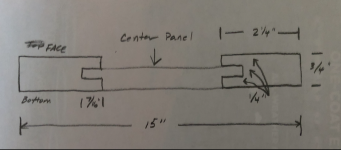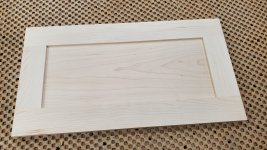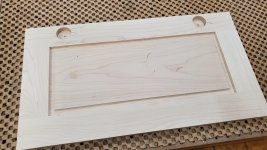Rick Herrick
Member
- Joined
- Feb 7, 2020
- Messages
- 793
I have made a number of simple doors and have always used a 1/4" plywood panel. I am working on a dresser for my daughter and I am double/triple checking everything so I get this right. I am roughly following a set of plans I got from a YouTube'r. I don't think the plans really accounted for side to side movement of this panel. I have a rough drawing here showing the top/bottom view of the side panel. The rail/stile width is 2-1/4" and the total panel width will be 15". The plan is calling for a 7/16" deep groove to house the panel. This panel is 1/2" thick and will have a 1/4" tongue routed (7/16" deep) to go into the groove in the rail/stiles.
Assuming I wanted a snug fit (which I do NOT), the width of this panel would 11-3/8 which is
15" total - 2x stile width of 2-1/4" + 2x the 7/16" tongue
(15) - (4-1/2) + (7/8) = 11-3/8
I am using white oak for all and I am making these panels now, in the cold time of the year. Is there a rule of thumb of how much narrower this panel needs to be ?
Assuming I wanted a snug fit (which I do NOT), the width of this panel would 11-3/8 which is
15" total - 2x stile width of 2-1/4" + 2x the 7/16" tongue
(15) - (4-1/2) + (7/8) = 11-3/8
I am using white oak for all and I am making these panels now, in the cold time of the year. Is there a rule of thumb of how much narrower this panel needs to be ?



